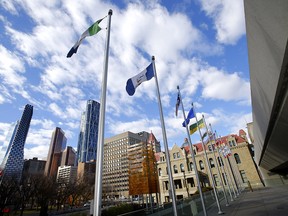There was big spending from parties looking to sway votes in the fluoridation plebiscite, but only one side disclosed their finances

Overall, they raised $1.71 million, and spent $1.62 million on their campaign. They endorsed 14 candidates for council, nine of whom were elected, including Mayor Jyoti Gondek.
Calgary Tomorrow, which had the singular focus of supporting former councillor Jeff Davison’s failed mayoral bid, raised about $422,000 and spent an estimated $394,000 on its campaign.
That’s in addition to the $360,000 spent by Davison’s campaign, which saw him finish a distant third behind Gondek and runner-up Jeromy Farkas.
The other six TPAs spent considerably less, ranging from a high of $106,000 for the Look Forward Society for Political Action of Alberta to only $625 for ABC Ward 12 YYC.
Under provincial law, TPAs can endorse candidates and spend money to publicly promote their preferred choices. They have more freedom than individual campaigns in accepting money: unlike candidates, they can accept corporate or union donations, and they can accept up to $30,000 from a single source, six times the limit for council campaigns.
Disclosures from TPAs on where they raised their money and how they spent it were due to Elections Calgary by March 1, but the city refused to disclose them publicly, instead requiring freedom of information requests to access them.
The city’s release of the disclosures redacted the names of financial contributors to the TPAs.
That drew criticism from some, including former Mayor Naheed Nenshi, who questioned the decision to redact names and called for reform to election financing laws.
“This is really upsetting. The legislation clearly requires disclosure … Donors I spoke to certainly knew their contributions would be disclosed,” Nenshi said on Twitter. “We need much better legislation now.”
Financial disclosures for election candidates were made public at the beginning of March, with the names of donors included.
Those disclosures showed candidates spent big in their pursuit of a seat on council, especially the mayoral frontrunners; Gondek’s campaign spent more than $633,000, and Farkas’s expenses totalled about $821,000.
Big spending in fluoride battle, but disclosures only from one side
A hotly contested battle in the 2021 election was the plebiscite on reintroducing fluoride to Calgary’s water supply. Calgarians voted 61.6 per cent in favour of bringing back fluoride, and the new council voted 13-2 to reinstate the practice as one of their first items of business.
Both advocates and detractors of water fluoridation ran campaigns to sway voters in the plebiscite. But only Fluoride Yes! registered as a TPA and disclosed its finances, while anti-fluoride group Safe Water Calgary declined to do so.
According to its disclosure, Fluoride Yes! spent more than $44,000 in its effort to bring the additive back to tap water.
Campaign spokesperson Juliet Guichon penned a letter to the premier’s office in the wake of the election pushing for reform to election laws that would strengthen the requirements for registering as a TPA.
“It was an uneven playing field. We tried to do everything by the book. We registered, we disclosed, we turned away cheques that weren’t from Alberta,” Guichon said.
“The Local Authorities Election Act permitted them to accept foreign funding, and not to register. We think we outspent them three-to-one, based on what they purchased.”
Guichon argued all parties involved in campaigns involving election issues should be mandated to disclose the sum of their donations, and where that money came from.
Safe Water Calgary director Bob Dickson has acknowledged receipt of funds from out of Canada, including from the Fluoride Action Network in the United States, but maintained the bulk of donors to his group’s no-vote campaign were local.
He declined to disclose his group’s total expenses, but said their efforts included mailing out 410,000 pamphlets to city homes. He added the decision not to register was made in part to protect donors, saying he worried they would come under attack.
“We’re not a third-party advertiser and there’s no legal requirements for us. We’re simply a volunteer campaign that raised some money to pay for signs and pay for our mail-outs to Calgary households,” Dickson said.
Dickson argued although his group “may have outspent them on the dollars and cents for this actual campaign,” they were disadvantaged due to broad support for fluoridation from medical associations and professionals who have wide reaches. Guichon, meanwhile, said her group was disadvantaged in the campaign by adhering to rules for TPAs her opponents weren’t required to follow.
According to Alberta Health Services, community water fluoridation is safe and effective, with local data showing children living in areas with fluoridated tap water have fewer cavities.
*Original article online at https://calgaryherald.com/news/local-news/third-party-advertisers-funnelled-more-than-2m-into-calgary-election
